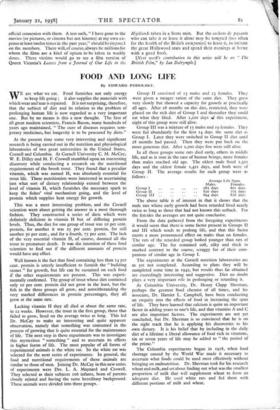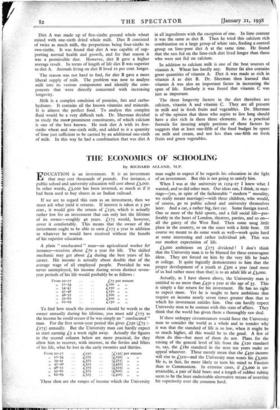FOOD AND LONG LIFE
By EDWARD PODOLSKY.
WE are what we eat. Food furnishes not only energy to keep life going ; it also supplies the materials with which wear and tear is repaired. It is not surprising, therefore, that the subject of diet and its relation to the problem of prolonging human life is now regarded as a very important one. But by no means is this a new thought. The first of all great modern scientists, Francis Bacon, many hundreds of years ago maintained, " The cure of diseases requires tem- porary medicines, but longevity is to be procured by diets."
At the present time some very interesting and significant research is being carried out in the nutrition and physiological laboratories of two great universities in the United States, Cornell and Columbia. At Cornell University C. M. McCay, W. E. Dilley and M. F. Crowell stumbled upon an interesting discovery while conducting a research on the nutritional requirements of the brook trout. They found that a peculiar vitamin, which was named H, was absolutely essential for trout life. These nutritionists were interested in ascertaining just what sort of dietary relationship existed between the level of vitamin H, which furnishes the necessary spark to keep the fishes' vital mechan'sm going, and the level of protein which supplies heat energy for growth.
This was a most interesting problem, and the Cornell scientists went about getting the answer in a most thorough - fashion. They constructed a series of diets which were definitely deficient in vitamin H but of differing protein levels. Thus, the diet for one group of trout was Da per cent. protein, for another it was 25 per cent. protein, for still another 5o per cent., and for a fourth, 75 per cent. The lack of the very essential vitamin H, of course, doomed all the trout to premature death. It was she intention of these food scientists to find out if the different amounts' of protein would have any effect.
Well known is the fact that food containing less than 14 per cent. protein is utterly insufficient to furnish the " building stones " for growth, but life can be sustained on such food if the other requirements are present. This was experi- mentally confirmed. The group of trout whose diet contained only to per cent. protein did not grow in the least, but the fish in the three groups all grew, and notwithstanding the very marked differences in protein percentages, they all grew at the same rate.
Lacking vitamin H they all died at about the same rate, in I2 weeks. However, the trout in the first group, those that failed to grow, lived on the average twice as long. This led Dr. McCay to make an interesting and quite apparent observation, namely that something was consumed in the process of growing that is quite essential for the maintenance of life.- The next step in these experiments was to investigate this mysterious " something " and to ascertain its effects in higher forms of life. The most popular of all forms of experimental animals is the white rat. So the white rat was selected for the next series of experiments.- In general, the food and nutritional requirements of these animals are similar to those of men. Joining Dr. McCay in this new series of experiments were Drs. L. A. Maynard and Crowell. They selected as their subjects 106 infants, born of parents closely related -and having the same hereditary background. These; animals were divided into three groups. - Group II consisted of 13 males and 23 females. They were given a meagre ration of the same diet. They grew very slowly but showed a capacity for growth at practically all ages. After 28 months on this diet, restricted, they were placed on the rich diet of Group I and thereafter they could eat what they liked. After 1,200 days of this experiment, eight of this group were still alive.
Group III was a mixture of 15 males and 19 females. They were fed abundantly for the first 14 days the same diet as Group I. Later they were switched to Group II diet until 28 months had passed. Then they were put back on the more generous diet. After 1,200 days five were still alive.
In all three groups some rats died early, others in middle life, and as is true in the case of human beings, more females than males reached old age. The oldest male lived 1,321 days and the oldest female 1,421 days, and both were of Group II. The average- results for each group were as follows :
Average Life Span.
Males. Females.
Group I • • • • 983 days 801 days Group II 820 days 775 days
Group III .. • • • • 894 days 826 days The above table is of interest in that it shows that the male rats whose early growth had been retarded lived nearly twice as long as those that had not known this setback. For the females the averages are not quite conclusive.
From the data gathered from the foregoing experiments it would seem that there is some factor present in Groups II and III which tends to prolong life, and that this factor exerts a more pronounced effect on males than on females. The rats of the retarded group looked younger than rats of similar age. The fur remained soft, silky and thick in marked contrast to the coarse, scraggy fur of their com- panions of similar age in Group I.
The experiments at the Cornell nutrition laboratories are as yet not completed. According to plans they will be completed some time in 1942, but results thus far obtained are exceedingly interesting and suggestive. Diet no doubt plays a very important role in prolonging or retarding it.
At Columbia University, Dr. Henry Clapp Sherman, perhaps the greatest- -food chemist of all times, and his associate, Dr. Harriet L. Campbell, have been conducting an enquiry into the effects of food in increasing the span of life. They have learned that calcium is quite an important • factor in adding years to life, and that vitamins A and C are also important factors. The experiments are not yet concluded, but Dr. Sherman is so convinced that he is on the right track that he is applying his discoveries to his own dietary. It is his belief that by including in the daily diet of a lifetime a liberal allowance of food rich in vitamins, six or seven years of life may be added to " the period of the prime."
The Columbia experiments began in 1918, when food shortage caused by the World War made it necessary to ascertain what foods could be used most effectively without bringing on malnutrition. Dr. Sherman took for his research wheat and milk, and set about finding out what was the smallest proportion of milk that will supplement wheat to form an adequate diet. He used white rats and fed them with different portions of milk and wheat, Diet A was made up of five-sixths ground whole wheat mixed with one-sixth dried whole milk. Diet B consisted of twice as much milk, the proportions being four-sixths to two-sixths. It was found that diet A was capable of sup- porting normal health and growth, and for that reason it was a permissible diet. However, diet B gave a higher average result. In terms of length of life diet B was superior to diet A. Animals living on diet B lived to per cent. longer.
The reason was not hard to find, for diet B gave a more liberal supply of milk. The problem was now to analyse milk into its various components and identify the com- ponents that were directly concerned with increasing longevity.
Milk is a complex emulsion of proteins, fats and carbo- hydrates. It contains all the known vitamins and minerals. It is almost the perfect food. To analyse this complex fluid would be a very difficult task. Dr. Sherman decided to study the most prominent constituents, of which calcium is one of the best known. He took diet A with its five- sixths wheat and one-sixth milk, and added to it a quantity of lime just sufficient to be carried by an additional one-sixth of milk. In this way he had a combination that was diet A in all ingredients with the exception of one. In lime content it was the same as diet B. Then he tried this calcium rich combination on a large group of white rats, feeding a control group on lime-pooi diet A at the same time. He found that the rats fed on the lime-rich diet lived longer than those who were not fed on calcium.
In addition to calcium milk is one of the best sources of vitamin A. Wheat has hardly any. Butter fat also contains great quantities of vitamin A. Diet A was made as rich in vitamin A as diet B. Dr. Sherman then learned that vitamin A was also an important factor in increasing the span of life. Similarly it - was found that vitamin C was just as important.
The three longevity factors in the diet therefore are calcium, vitamin A and vitamin C. They are all present in milk and in fresh fruits and vegetables. Dr. Sherman is of•the opinion that those who aspire to live long should have a diet rich in these three elements. As a practical formula for insuring ample portions of these factors he suggests that at least one-fifth of the food' budget be spent on milk and cream, and not less than one-fifth on fresh fruits and green vegetables.















































 Previous page
Previous page